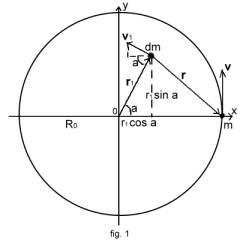Dark Matter - Gravo-Dynamic Force
Laszlo I. Orban & Laszlo T. Orban
Astronomic measurements shows that the stars situated at the margins of the galaxies are moving at a higher speed than the circumferential speed that would result from the mass of these galaxies. This can be observed even in much larger scales, at galaxy clusters. Where it was determined that the galaxy cluster’s elements are moving at a faster speed than what belongs to the circumferential speed corresponding to the gravific mass of the galaxy cluster. An assumed explanation for this phenomenon is that beside the visible matter, the 2/3 part of the Universe is filled up of such matter that only gravific effects manifest in cosmic movement of matter. The nature of “Dark Matter” is the fundamental question in modern astrophysics.
However, the gravitational effect of “Dark Matter” could be eliminated assuming that between the streams of matter, such gravo-dynamic forces appears that is similar to Lorentz’s electrodynamic force. This force in case of same stream directions it attracts, and in case of contrary stream directions it repels. Generally, a body of mass m1 with a velocity v1 on a body of mass m2 with a velocity v2 has a force F1,2 that the following connection provides:
F1, 2 = (Gd∙m1∙m2∙r -31, 2) v2 x (v1 x r1, 2)
Here, r1, 2 is the position vector
oriented from m1 to m2. The dimension of Gd gravodynamic
constant is kg -1m. Presumably, the numeric value of Gd
gravodynamic constant is so small that in case of earth’s streams of matter the
gravodynamic force is negligible and only the cosmic sized movements can be
observed. The possible explanation for the gravodynamic force can be found in
the study which’s located at
http://members.shaw.ca/laszlo.o/....
Gd’s numeric value can be estimated, if we presume
that excess velocity of the Milky Way’s peripheral stars are caused by the attraction effects of
the gravodynamic forces’ sum resulting from the moving perceptible matter and not from the “Dark
Matter’s” attracting effect.
 Presuming in the first approximation that all stars of Galaxy of masses M are
placed on a circular plain disk with a radius of R0≈3.78
∙ 1021m with a uniform density ( ρ=M/π R02
).
Presuming in the first approximation that all stars of Galaxy of masses M are
placed on a circular plain disk with a radius of R0≈3.78
∙ 1021m with a uniform density ( ρ=M/π R02
).
The Milky Way’s circulational periodic time T=240 million year that has an angular velocity of ω=2 π/T≈8.3 ∙ 10-16rad ∙ s-1. For the easier calculation let the star be m mass on the x axle the distance of R0 from the centre of Galaxy (0) and be moving at the velocity of v=R0 ∙ ω (Fig. 1.). The part of matter with the mass dm and with speed v1=r1∙ ω will have a gravodynamic affection of
dF = Gd ∙ m∙ρ∙ds∙r-3∙ v x (v1 x r)
on the star of m mass and v velocity.
Based on fig.1 the x and y components of vectors are the following: vx=0; vy=R0 ∙ ω; v1x=-r1∙ ω ∙ sin a; v1y = r1 ∙ ω ∙ cos a; rx = R0-r1∙ cos a; ry = -r1 ∙ sin a. After the completion of the three-vector multiplication, we will have a vector with the module |vx x (v1 x r)| = r1 ∙ R0 ∙ ω2 ∙ (r1 – R0 ∙ cos a). This vector falls in the x axis and points towards the centre of Galaxy:
| dF = Gd . p . R0 . w2 . | r1 . ( r1 - R0 . cos a ) . ds |
| ( R02 - 2 . r1 . R0 . cos a + r12)3/2 |
Thus, the sum of the gravo-dynamic forces provided by all the “elements” of the Galaxy on the peripheral star with the mass “m” and velocity v are the following:

Thus:
|F| = Gd ∙ m ∙ ρ ∙ R0 ∙ ω2 ∙ I
Here, l ≈ 1.2 ∙ 1016 m means the average star distance in the Galaxy while I is the approximate value of the integral.
This force substitutes the Fg force that’s assigned to Galactic “Dark Matter” referenced to the peripheral star with m mass. Based on observations the hypothetic dark matter’s Mg mass is 2/3rd of the whole Mtot mass, while the visible galactic matter is only 1/3rd. This way Mg = 2M so:
Fg = G ∙ Mg ∙ m ∙ R0-2 = G ∙ 2M ∙ m ∙ R0-2 (G = gravitational constant)
Equalizing the two forces will result:
Gd ∙ ρ ∙ R0 ∙ ω2 ∙ I ∙ m = G ∙ 2M ∙ m ∙ R0-2
Substituting the value of ρ = M/ π R02 after simplification:

The approximate value of I is I≈1.2669 ∙ 1022 m so Gd ≈ 1.27 ∙ 10-23 kg-1m. The dimensions of Gd are corresponding with the dimensions of the expression G/c2 (c = speed of light). This fact refers to the deep structure of gravodynamic force. In the study: http://members.shaw.ca/laszlo.o/.... based on another hypothesis, for the expression of gravodynamic constant derived:

Here me = 9.1 ∙ 10-31 kg, this
is the mass of electron; mk = 3 ∙ 10-35 kg is the
mass of neutrino while G is 6.67 ∙ 10-11 kg-1m3s-2
and finally c = 3 ∙ 108 ms-1
So after substituting these values we’ll have Gd = 1.59 ∙ 10-23 kg-1m. The Gd values resulted from two different ways differentiate little from each other. This fact confirms the reality of hypothesizes.
It is presumed that the complicated movement of Galaxy clusters’ excess speed is not produced by the undetectable “Dark Matter”, but the gravodynamic forces.
The important part of astrophysical researches is constituted of the determination of the exact value of Gd with the help of more detailed models and modern computer technologies.